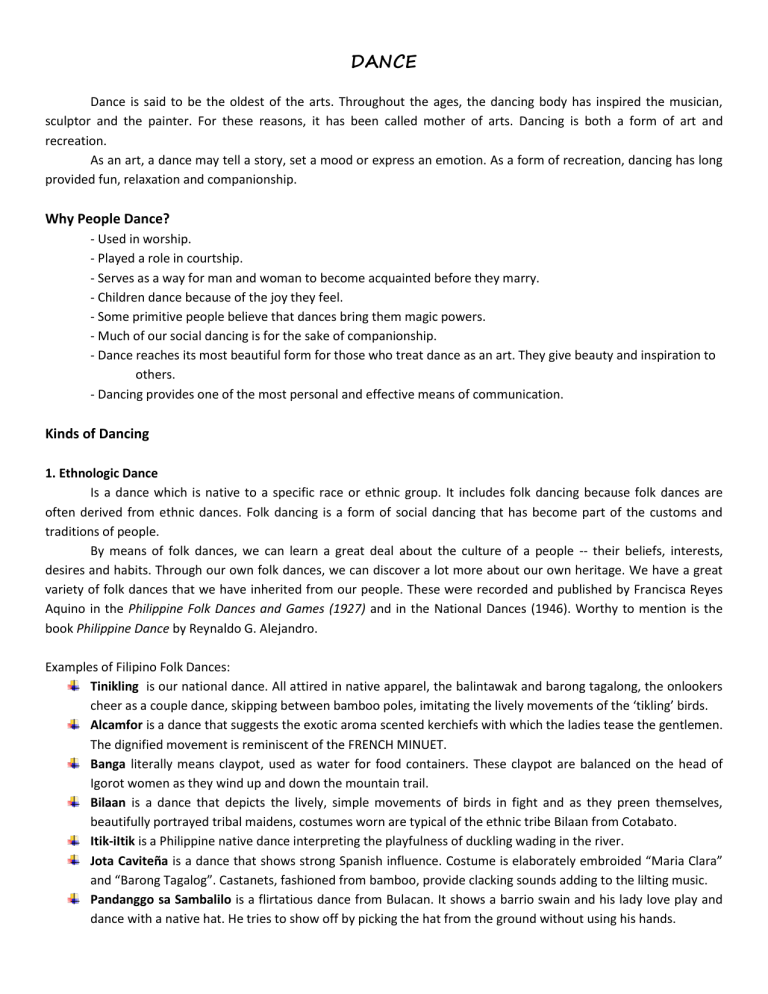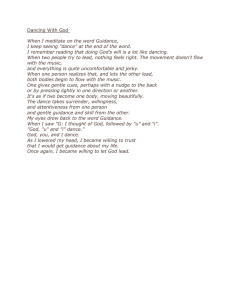
DANCE Dance is said to be the oldest of the arts. Throughout the ages, the dancing body has inspired the musician, sculptor and the painter. For these reasons, it has been called mother of arts. Dancing is both a form of art and recreation. As an art, a dance may tell a story, set a mood or express an emotion. As a form of recreation, dancing has long provided fun, relaxation and companionship. Why People Dance? - Used in worship. - Played a role in courtship. - Serves as a way for man and woman to become acquainted before they marry. - Children dance because of the joy they feel. - Some primitive people believe that dances bring them magic powers. - Much of our social dancing is for the sake of companionship. - Dance reaches its most beautiful form for those who treat dance as an art. They give beauty and inspiration to others. - Dancing provides one of the most personal and effective means of communication. Kinds of Dancing 1. Ethnologic Dance Is a dance which is native to a specific race or ethnic group. It includes folk dancing because folk dances are often derived from ethnic dances. Folk dancing is a form of social dancing that has become part of the customs and traditions of people. By means of folk dances, we can learn a great deal about the culture of a people -- their beliefs, interests, desires and habits. Through our own folk dances, we can discover a lot more about our own heritage. We have a great variety of folk dances that we have inherited from our people. These were recorded and published by Francisca Reyes Aquino in the Philippine Folk Dances and Games (1927) and in the National Dances (1946). Worthy to mention is the book Philippine Dance by Reynaldo G. Alejandro. Examples of Filipino Folk Dances: Tinikling is our national dance. All attired in native apparel, the balintawak and barong tagalong, the onlookers cheer as a couple dance, skipping between bamboo poles, imitating the lively movements of the ‘tikling’ birds. Alcamfor is a dance that suggests the exotic aroma scented kerchiefs with which the ladies tease the gentlemen. The dignified movement is reminiscent of the FRENCH MINUET. Banga literally means claypot, used as water for food containers. These claypot are balanced on the head of Igorot women as they wind up and down the mountain trail. Bilaan is a dance that depicts the lively, simple movements of birds in fight and as they preen themselves, beautifully portrayed tribal maidens, costumes worn are typical of the ethnic tribe Bilaan from Cotabato. Itik-iItik is a Philippine native dance interpreting the playfulness of duckling wading in the river. Jota Caviteña is a dance that shows strong Spanish influence. Costume is elaborately embroided “Maria Clara” and “Barong Tagalog”. Castanets, fashioned from bamboo, provide clacking sounds adding to the lilting music. Pandanggo sa Sambalilo is a flirtatious dance from Bulacan. It shows a barrio swain and his lady love play and dance with a native hat. He tries to show off by picking the hat from the ground without using his hands. Sayaw Ed Tapew na Bangko - a couple “showing off” their skills while dancing on top of a long and narrow bench. Singkil is a famous dance from Mindanao. The Princes, the Prince, and their retinue, in a pose of the Singkil. This is an intricate dance where the dancers’ feet dart precariously in and out of a complicated pattern of clacking bamboo poles. The Ifugao Dance depicts a mountain tribe of the Philippines dancing to the sound of the “gangsa” (brass gong) 2. Social or Ballroom Dances - are a popular type of dancing generally performed by pairs. They include such forms as waltz, fox trot, swing, and the old favourites as the cha-cha, boogie, tango, as well as the latest rock dances. Most of them have specific steps and rhythm but many newer ones allow the dancers to compose their own movements as they dance. Some popular dances were considered shocking when they first appeared. When the waltz first appeared, man y people thought of it as disgraceful because it required close contact between partners. Later, “cheek to cheek” dancing was believed to be sinful. The suggestive movements of some rock dancers in the middle 20 th Century were criticized as vulgar. Ballroom dancing is presently undergoing a period of revival which is not only enjoyed and appreciated by the elders but also the youngsters as well. It is now known as the famous dance sports where local, national and international participants join the competition because it offers lucrative prizes such as cash, plaque, material rewards, and privilege to travel around the world to the winners. Aside from being regarded as a source of public entertainment, ballroom dancing is also an effective exercise as prescribed by medical practitioners to young professionals whose work is sedentary in nature. 3. Theatrical or Spectacular Dance This type of dance is so called because it is performed for the entertainment of spectators. Theatrical dancing includes the ballet, modern dance, musical comedy dances, and tap dancing. a. Ballet - is the formalized type of dance which has its origin in the royal courts of the Middle Ages. It is the great spectacular dance form of the Western World and perhaps even in our country now. The term ballet refers to a series of solo and concerted dances in which poses and steps are combined with light flowing figures, accompanied by music and scenic accessories expressive of a dramatic story, theme or atmosphere. Thus, ballet includes staging, scenery, costumes, dancing and music, but no dialogue and no singing. b. Modern Dance - is a dance form characterized a s natural and free. It does not stick to conventions, and has varied styles of movements, usually based on the current trend. it has also been called expressional dance. Modern dance developed in the early 1900’s. New forms to the dance started with the ideas of Isadora Duncan, who was inspired by the art of ancient Greece, and preached the natural use of the body clothed in easy flowing garments. The dance comes from within the performer. He follows no set of patterns, but creates his own movements and style according to the idea for the dance. Modern Dances are sometimes called contemporary or interpretative dances. As mentioned earlier, these dances represent a rebellion against the classical formation of the ballet; they emphasize personal communication of moods and themes. The modern dancer bases his movements upon the natural movements of the human body which is in turn, deals with skill and balance, tension and relaxation. The modern dance was influenced by other kinds of dancing. Musical Comedy has borrowed much from the modern dance. Elements of Dance 1. Theme - content or main ingredient of the dance. It tells us what a dance is trying to tell or convey. 2. Design - refers to the planned organization or pattern of movement in time and space. 3. Movement - action of dancers as they use their bodies to create organized patterns. 4. Techniques - skill in executing movement. 5. Music - plays an important role in dance to which it is closely related. it is something melodic and harmonious usually used as accompaniment. 6. Costume and Properties - The visual elements of costumes and properties also contribute to dance. 7. Choreography - Dances during the ancient times were disorganized. Today, dances are performed in an organized manner, following steps and movements. 8. Scenery - setting or background establishing the place of action of any dance is important to make the dance more realistic and beautiful.


